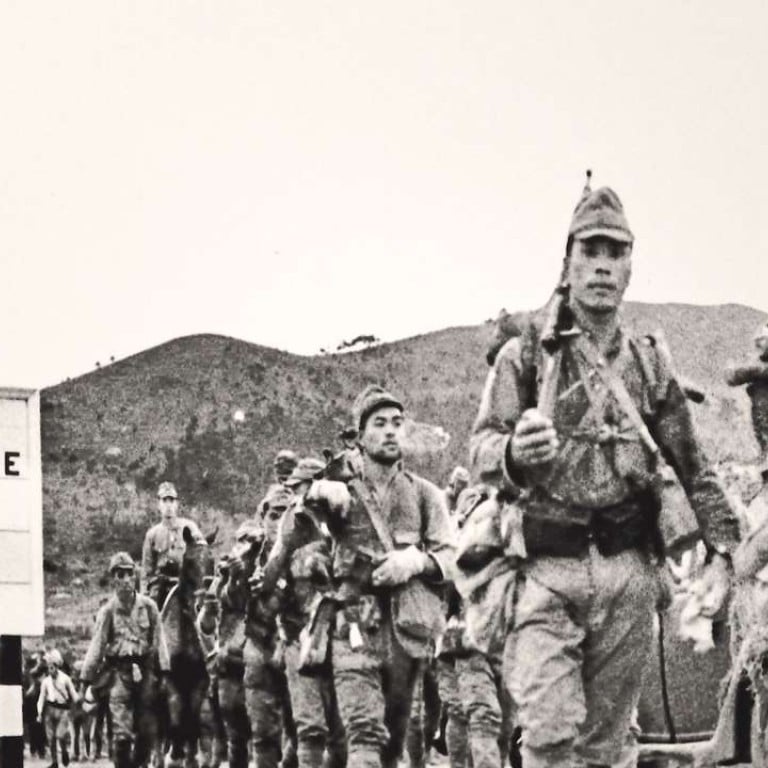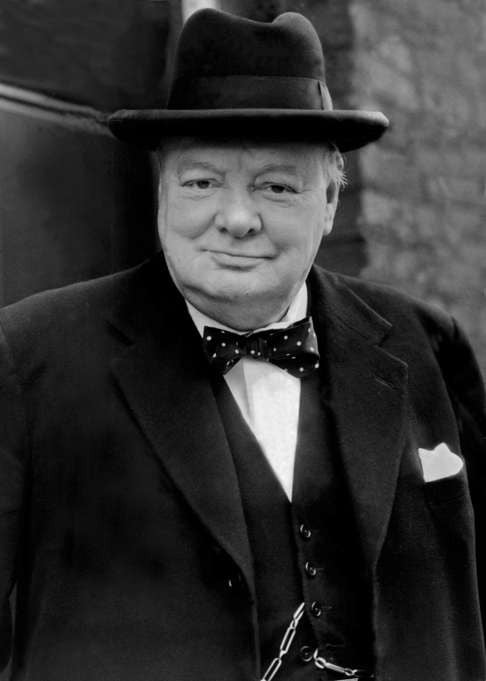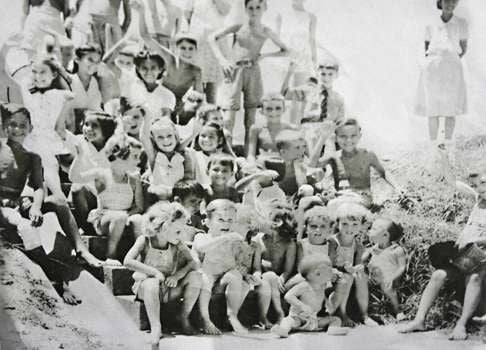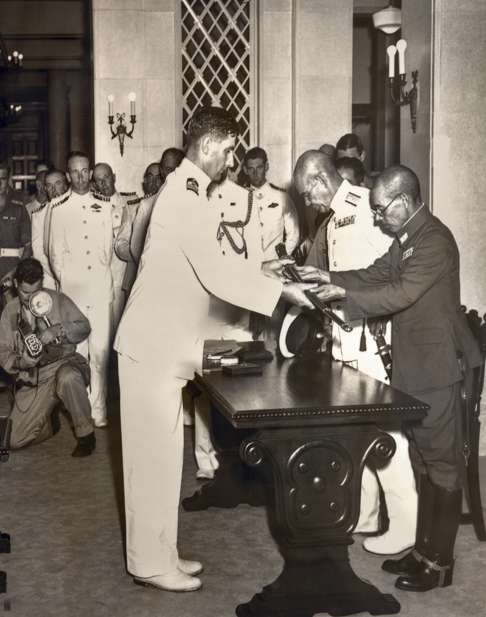
Why Churchill didn’t want Hong Kong defended against Japanese, and how the colony survived wartime occupation
Archives show British leader opposed sending more troops because he didn’t believe colony could be safeguarded, how Hong Kong officials sought co-operation with occupiers, and how colonial rule was quickly revived
After the Japanese invasion of northeastern China in 1931, there were mixed views in London concerning the extent of Hong Kong’s defences, as it was firmly believed it would be difficult for the colony to withstand a Japanese attack. Indeed, talks in London were less about how to defend Hong Kong than how to regain British sovereignty after the war, archives reveal. The British did not want to see Hong Kong handed over to the Chinese Nationalist government led by Chiang Kai-shek in the event of a Japanese defeat.
During governor Sir Geoffrey Northcote’s term of office (1937-41), the war escalated in China and Hong Kong was swamped by 100,000 refugees. Addressing a special meeting of the Legislative Council on October 13, 1938, Northcote mainly discussed the usual domestic and economic issues. But in conclusion, he noted that his address was printed before the invasion of neighbouring Kwangtung (Guangdong) province by the Japanese forces.
“The outbreak of hostilities so close to the border,” he told legislators, “is a matter of grave and regretful concern. As I have pointed out already, three quarters of our fresh vegetables and a large portion of our fresh meat supplies have come from that province.
“Secondly, the colony must face the prospect of an additional serious refugee problem arising from this invasion ... These, together with the military and police precautions, which are necessary in such circumstances, will entail heavy charges upon the colony’s funds. Again, this interruption of Hong Kong’s long-established trade with China will bring heavy losses upon the revenue and upon commerce.”

Hong Kong was heading for trouble. According to UK parliamentary transcripts, when telegrams reached him from General Ismay, commander-in-chief in the Far East, urging the reinforcement of Hong Kong, British prime minister Winston Churchill replied: “This is all wrong. If Japan goes to war, there is not the slightest chance of holding Hong Kong or relieving it. It is most unwise to increase the loss we should suffer there. Instead of increasing the garrison, it ought to be reduced to a symbolical scale. Japan will think twice before declaring war on the British Empire and whether there are two or six battalions in Hong Kong will make no difference to her choice. I wish we had fewer troops there, but to move any would be noticeable and dangerous.”
But his cabinet thought otherwise and eventually persuaded Churchill that this British outpost needed defending due to its strategic position in the South China Sea. Canadian prime minister Mackenzie King answered Churchill’s plea for help and immediately sent two battalions to Hong Kong.
Meanwhile, Northcote’s health was deteriorating, and in late 1940 he took six months’ leave in the UK, returning to Hong Kong in March 1941. However, since his condition had not improved he was forced to retire in September that year.

That same month, Sir Mark Aitchison Young arrived in Hong Kong fresh from the Tanganyika Territory British Mandate in East Africa, where he had been governor and commander-in-chief. The Japanese were on Hong Kong’s doorstep. They had seized control of Canton (Guangzhou) and reached Shum Chun (Shenzhen). Understandably Young’s welcome ceremony was somewhat subdued.
There is not the slightest chance of holding Hong Kong or relieving it. It is most unwise to increase the loss we should suffer there
The welcome address was delivered by senior non-official Executive Councillor Sir Robert Kotewall in the presence of former Executive and Legislative councillor Sir Shouson Chow and all legislators, representatives of all consulates in Hong Kong and local businessmen.
Two months later the Legislative Council held its last meeting for the year with the final item on the agenda being an amendment to the Magistrates Ordinance introducing community service as a penalty for minor offences to alleviate overcrowding in Stanley Prison. It was not until 4½ years later that the Legislative Council was reconvened.

Timed to coincide with the sneak air attack on Pearl Harbour, the Japanese advance across the border at Lo Wu, on December 8, 1941, overcame all resistance and swept so rapidly through the New Territories hinterland that only the harbour offered a brief respite for those holding out on the island. The end was swift. On Christmas Day a party of British colonial officials, headed by governor Young, crossed the harbour to surrender to the Japanese on the third floor of The Peninsula hotel.
In January 1942, a covert meeting was held to discuss grave concerns regarding the well-being of Hong Kong people. Secretary for Chinese Affairs R.A.C. North, Attorney General Grenville Alabaster and Defence Secretary J.A. Fraser suggested to Kotewall, Shouson Chow and other members of the Executive Council that they co-operate with the Japanese in the interests of the Chinese community. It was felt that otherwise the locals would suffer inhumanely at the hands of the occupation forces. Takashi Sakai and Masaichi Niimi, of the Japanese Imperial Army, had already incarcerated 2,500 British loyalists in a camp next to the overcrowded Stanley Prison. Among them was Colonial Secretary Franklin Gimson, who had arrived on December 7, on the eve of the invasion. Hong Kong was ruled under martial law, headed by General Rensuke Isogai, who set up his administration and command post in The Peninsula hotel, where Governor Young was incarcerated in Room 336 before being transferred to Formosa (Taiwan) and eventually Manchuria.

Isogai’s administration included a number of departments – political, civilian, economy, judiciary and the navy – each headed by an executive bureau. But the bloody executions, rape and pillage in the newly claimed territory sent shivers through the community and caused a mass exodus: the population dwindled to 600,000 from its pre-occupation level of 1.6 million. Isogai had clearly not secured the co-operation of the community, so he set up two consultative councils to bridge the gap between the populace and the administration. The first was the Representative Council – in a role similar to the Executive Council – as executive body, chaired by Kotewall, who had led the welcoming committee for the Japanese. To distance himself from the former British administration, Kotewall changed his name to Lo Yuk-wo.
The second body was the larger, 22-member Co-operative Council, whose membership was proposed by the upper Representative Council. This was chaired by Shouson Chow and consisted of other prominent community members, including former legislators Dr Li Shu-fan, Lo Man-kam and a founder of the Chinese Chamber of Commerce, Ip Lan-chuen. But the councils were window dressing only and the local members began avoiding their duties and meetings. Kotewall and legislator Li-Tse-fong withdrew from public life, citing health reasons.

Although ill-timed, the arrival of Gimson, former administrator of Ceylon (Sri Lanka), as Hong Kong’s new colonial secretary made him the obvious successor to Young when the latter was banished. Gimson therefore became the British representative responsible for dealing with the Japanese in matters related to the transfer of power. After setting up a provisional liaison office in Prince’s Building in Central, Gimson was transferred to the Stanley camp where, as the highest ranking British official, he became chairman of the British Communal Council and was responsible for negotiating with the Japanese on camp affairs.
On the eve of the Japanese surrender on August 15, 1945 the British ambassador to China, Sir Horace Seymour, tried to contact Gimson from Chongqing, authorising him to exercise sovereignty over Hong Kong on behalf of the British government. Seymour’s brief was that if the British did not seize immediate control, Hong Kong could be handed over to the Nationalist government. However, Seymour’s instructions did not arrive until August 23. Luckily Gimson had acted on instinct and, on hearing of the surrender by radio, he immediately declared himself acting governor, being sworn in on August 16 by the Chief Justice Sir Atholl MacGregor, who was also interned in Stanley, to assume administration of Hong Kong.
Gimson and other colonial officials set up headquarters in the French Mission Building (now the Court of Final Appeal in Battery Path) and on August 27 announced that a provisional government had been formed. A frail Gimson held the fort until the arrival of Admiral Sir Cecil Harcourt three days later.
Harcourt formally proclaimed a British military administration on September 1, 1945 with himself as head and Gimson as his lieutenant governor. However, this was not approved in London, as there could not be a co-existence of military and civilian administration. Hong Kong remained under military rule until Young was sufficiently recovered from convalescence in London to return to Hong Kong and restore civil administration on May 1, 1946. Gimson was appointed governor of Singapore.

In his May 1 welcome address, Governor Young noted: “Whatever changes may be in store, this Council, which though not yet complete in numbers, is today able to resume its sitting after so long an interval, is, I am convinced, destined to play in the future as it has in the past, an honourable and valuable part in the life of the Colony and in the promotion of its welfare.” And from that day on politics in Hong Kong took a new lease on life.
Mark Pinkstone is a former chief information officer of the Hong Kong civil service. Sources: Hong Kong Public Records Office archives and UK Hansard
